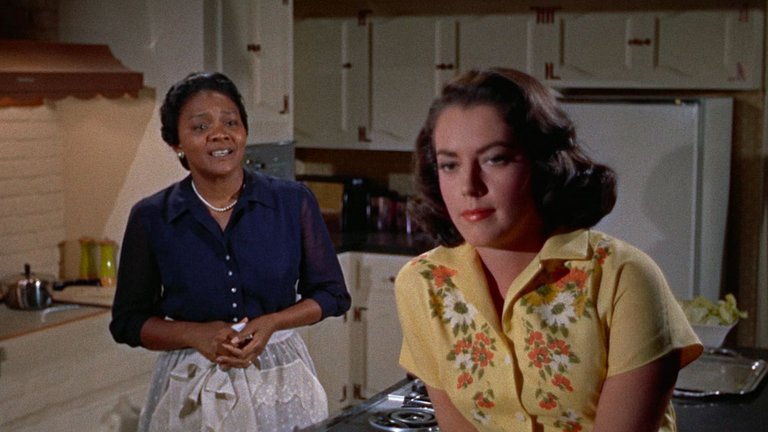
Many film directors dream of ending their careers with high notes, and few succeeded in making such a dream a reality as much as Douglas Sirk did. His 1959 melodrama, Imitation of Life, is considered not only one of his best and commercially most successful films but also one of the iconic works of 1950s Hollywood. Based on the 1933 novel by Fannie Hurst, a popular author who liked to use sentimental melodramatic plots to talk about important social issues, the novel was first adapted to screen in 1934 with Claudette Colbert and Louise Beavers in the lead roles.
The plot of the new film begins in 1947 Coney Island, where Lora Meredith (played by Lana Turner), a widowed mother and aspiring stage actress, meets Annie Johnson (played by Juanita Moore), an African-American woman who had temporarily taken care of her lost young daughter Susie (played by Terry Burnham), who also befriended Annie's own daughter Sarah Jane (played by Karin Dicker). After discovering that Annie and Sarah Jane are homeless, Lora offers to house them in her small apartment, where Annie would earn her keep as a maid and assistant. Lora eventually manages to secure a big break on Broadway and becomes a great star, while Annie continues to live with her. Years later, Lora lives a comfortable life, but their adult daughters are unhappy. Sarah Jane (played by Susan Kohner), being light-skinned African-American woman, wants to pass as white and cannot live with her black mother, breaking her heart. Susie (played by Sandra Dee) is in love with Steve Archer (played by Robert Gavin), a photographer and Lora's former boyfriend, whom Lora still wants to marry.
Born as Hans Detlef Sierck, Sirk had a relatively long and fruitful career which began in Europe, but it is his last films in the 1950s – high-budget and stylish melodramas produced by immensely successful and influential producer Ross Hunter – that he is most known for today. In those films, Sirk showed great skill, using lush colour cinematography and sets that made ordinary middle-class America look like heaven, while making sharp contrasts between idyllic exteriors and protagonists' troubled lives caused by their personal demons or social divisions based on class, or in this particular case, race.
Imitation of Life is the film that, at the same time, celebrates 1950s America as the land of opportunity where anyone, whether an aspiring actress or maid, can achieve its own brand of American Dream, while also highlighting that this dream doesn't guarantee happiness. Sirk, obviously inspired by the emerging civil rights movement, insisted that the film does deal with racial divisions, taking it from the perspective of those who, like unfortunate Sarah Jane, can't belong to either of two worlds, being the product of miscenegation. Because of it, Sarah Jane, who since childhood desires nothing more than to be white, can never accept her black mother whose presence, despite Annie's best intentions, causes heartbreak and all kinds of trouble, most evidently in the disturbing scene when Sarah Jane gets viciously beaten by her white boyfriend who discovered her terrible secret.
Many filmmakers, especially in our "woke" times, would build entire films around the race-related plot, but Sirk was wise enough to use it only as one element of a larger picture. Imitation of Life shows that America's problems are much bigger than issues of race, and some have to do with different kinds of inequality based on gender roles. While Lora initially rejects the pimp-like suggestions of her slimy agent (played by Robert Alda), she is more than willing to enter into a transactional relationship with a successful playwright (played by Dan O'Herlihy) and only after she is sufficiently successful can afford romance with her true love, Steve.
This morally questionable role represented great risk for Lana Turner, just as casting her, following the 1958 scandal relating to the killing of her boyfriend Johnny Stompanato, represented a risk for producers. Turner, however, played that role with gusto and delivered a good performance, in many ways enhanced by $1 million worth of costumes designed for her character.
Turner is, however, overshadowed by Juanita Moore in the role of saintly and long-suffering Annie, as well as Susan Kohner, an actress who convincingly plays a woman of racially mixed ancestry despite being white in real life. Both performances were nominated for an Oscar for Best Supporting Actress. Sandra Dee, a young actress and model who enjoyed the zenith of her popularity at the time, is good but still overshadowed by those two actresses.
Despite becoming a major box office hit, Imitation of Life was originally rejected by critics who saw it as too "soapish" and melodramatic. Time, however, was very kind to Sirk's work, and Imitation of Life became one of the more memorable films which continued to gain audiences even in later decades.
The final, powerful scene of a funeral featuring Mahalia Jackson singing “Trouble of the World” is one of the most emotional moments in the history of Hollywood. Sirk, following Imitation of Life, despite being only 60, decided to end directing career and instead returned to his native Germany to teach in film schools. There were few better ways for a Hollywood legend to ride into the sunset.
RATING: 8/10 (+++)
Blog in Croatian https://draxblog.com
Blog in English https://draxreview.wordpress.com/
InLeo blog https://inleo.io/@drax.leo
Hiveonboard: https://hiveonboard.com?ref=drax
Rising Star game: https://www.risingstargame.com?referrer=drax
1Inch: https://1inch.exchange/#/r/0x83823d8CCB74F828148258BB4457642124b1328e
BTC donations: 1EWxiMiP6iiG9rger3NuUSd6HByaxQWafG
ETH donations: 0xB305F144323b99e6f8b1d66f5D7DE78B498C32A7
BCH donations: qpvxw0jax79lhmvlgcldkzpqanf03r9cjv8y6gtmk9
Posted Using InLeo Alpha